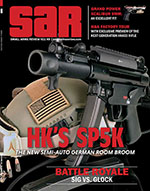NFATCA Report: V21N9
By Jeff Folloder
Emergencies and Your FFL
This column is being written at the end of August. Your author is typing away at his computer, located not too far from the Texas Gulf Coast as Hurricane Harvey prepares to make landfall. It has been nine years since a hurricane crossed the shore in Texas, and it appears as though there are far too many people who have forgotten that basic, common sense procedures involved in preparing for a major storm. Time marches on, and technology makes stunning progress, yet folks seem to revert to panic and passion in the run up to potential disaster.
I drove past a neighborhood gas station. There were nearly 80 cars haphazardly queued up, and tempers were quite short. I was in my truck waiting for the light to turn green, and I watched a three-way fist fight break out amongst part of the lined-up customers. Really? The local sports talk radio station was broadcasting a stream of head’s up announcements for where folks might be able to pick up bottled water (you know you can fill up containers from the tap, right?), diapers, generators, beer, plywood … and more. The rain has already started, and people are just now getting around to doing their prep work. The big box DIY home stores? Jammed. Grocery stores? Looks like a giant vacuum cleaner alleviated the shelves of everything. We’ve been through this before, and, yet, it seems as though nobody remembers how to do anything.
From out of the blue, my phone rings with a Washington, DC area code. It’s the ATF auto-dialer. A pre-recorded message begins to play alerting me to the fact that a severe storm is imminent and that I should take measures to secure the inventory of my Federal Firearms License. There is a lot for an FFL to secure:
- Firearms come to mind, first. They must be secured from natural peril and also the potential peril of looters, and such.
- The Acquisition and Disposition (A&D) book must be secured, but check with ATF on just how to go about removing it to a safe place.
- The 4473s must be secured, with the same ATF blessing.
- All the Multiple Handgun Sale (and Long Arm Multiples for border states) forms, too.
- All the Entity Acquisition Sworn Statements.
- All the NFA Forms.
- All the FFL copies (my IOI makes sure that I have them all during routine inspections).
Again, there is a lot to account for and secure. It makes sense to be prepared, doesn’t it? It’s not exactly prudent to start the preparation when disaster is on the doorstep. The best time to start preparations is long before they are needed. All the firearms are raised significantly above floor level and covered with plastic. All the records, paper and electronic, are ready to go. They have been duplicated and stored separately in their own Yeti coolers! The generators are regularly tested and confirmed as functioning. The gasoline supply is already in place. The portable air conditioner is ready to go (it is August in the Houston area, after all). Plenty of bottled water. Plenty of bottled gas for the grill in case it is time to start cooking up provisions that were “forced” to thaw. Flashlights abound. The chat with neighbors has been had, and we all have each other’s backs. I guess it’s time to sit back and see what happens, hoping that I do not receive the other call from ATF. The one that warns that there has been a burglary of a Federal Firearms Licensee in my area.
FFLs should never be in a reactive mode. For that matter, we should all be prepared for the possible. The NFATCA always aims to help its members prepare. So keep your powder (and your provisions) dry.
This article first appeared in Small Arms Review V21N9 (November 2017) |
| SUBSCRIBER COMMENT AREA |
Comments have not been generated for this article.



